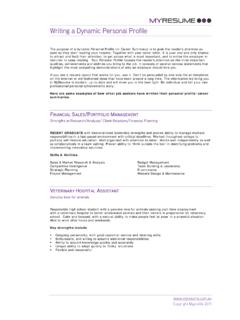Transcription of Employee Benefit Trends in India – challenges and ...
1 Employee Benefit Trends in India . challenges and opportunities Naveen Kumar Midha Naveen Midha is the Employee Benefits Practice Leader for Willis India . His career has included senior positions with various insurance entities in and outside India . During his eight years in the Indian insurance industry, Mr Midha has gained experience in areas of benefits design consulting and product design and has strategic and operational expertise in health-care management and other critical areas of Employee benefits. In his current role at Willis, he is responsible for the development and implementation of Employee Benefit activities design, placement, negotiation and servicing on behalf of companies. Mr Midha has a Bachelor of Business Studies degree from the University of Delhi and is a qualified Cost and Works Accountant (ICWA), India .
2 He also has an MS degree in Risk Management from The School of Risk Management, Insurance and Actuarial Science, St. John's University, New York, and a Master's degree in Finance from Delhi University. India a much-watched, analysed and observed country THE EXISTING HEALTH-CARE MARKET. is standing expectantly on the brink of economic An analysis of the prevailing demographic profile of supremacy and leadership. Before it can realize its vast, India will provide us with a common-sense check of the latent economic potential, however, it has to improve existing potential, changing shape and future growth of its rapidly expanding but equally challenge-ridden the health-care market in India . health-care system. While the impediments in this area are complex and unique, the opportunities are also The Population and its Health-Care Potential myriad and exciting.
3 On the one hand, we have the multi- The current primary driver of growth in the health-care faceted demands and expectations of the mushrooming sector is India 's enormous population. Estimated at middle class coupled with an ageing population, a larger billion, it is currently the second largest in the share of the global disease burden and a severely tested, world. It is growing at a rate of annually and is not-so-strong health-care delivery mechanism. On the expected to overtake that of China by 2030. By 2050, other hand, India has the fantastic opportunity to learn the population is projected to reach billion. from (and, in fact, pre-empt) the challenges that health- Importantly, this population includes a middle-income care systems of other developed countries are dealing group of around 385 million people1.
4 However, only with primarily by incentivizing private-sector 15 million are covered by private health insurance, participation in financing and delivery, improving access indicating the massive potential for growth. and quality and propelling the health insurance sector. In terms of revenues, in 2008 health insurance Amidst all these anticipated metamorphoses, we have premiums amounted to approximately US$450 million*. Corporate India with its own set of aspirations and as against the estimated potential of US$8 billion. If we responsibilities to cater to employees' concerns. As with look at the overall health-care market , it is growing at their peers in any other economy, Indian employers are a brisk 16%, with an estimated market potential of faced with an increasingly competitive search for skilled US$30 billion.
5 However, even at present levels, the employees, with their diverse expectations and market works out as US$30 per capita and is the demographic profile, which has brought about dramatic equivalent of only 6% of India 's gross domestic product changes to human resource management. The growing (GDP). This further indicates the enormous potential of complexities in products, ever-changing government the market. legislation and expanding administrative burdens are also posing new questions. Added to these challenges is Public Private Partnership in Health Care the spiralling benefits cost resulting in the excessive India spends around just of its GDP on health-care financial burden of health care for employers. In short, funding and less than a quarter of that sum on organizations in India are being challenged in all aspects the actual delivery of health-care programmes.
6 It of Benefit programmes. No wonder all this decision- is therefore of little surprise that in urban health care making is proving not to be an easy job for an Indian nearly 80% of funding comes from the private sector employer. This article explores the Employee benefits market in India and the emerging Trends . It details the existing health-care market and how it has evolved since the 1950s, elaborating on the present drivers of growth. * 1 = US$ ; 1 = US$ as at 13 November 2009. Finally, it describes the Trends associated with the market The health-care market includes retail pharmaceutical, (read Corporate India ) and how they are expected to health-care services, and medical and diagnostic evolve and have an impact over the next few years.
7 Equipment and supplies. Benefits & Compensation International DECEMBER 2009 3. and only 20% from the public sector. While the role private initiatives in health-care service delivery, while of central government is limited to family welfare at the same time widening access to publicly funded and disease control programmes, the state governments primary health care. This mainly benefited the urban are responsible for primary and secondary medical Employee . care, with a limited role in specialty care. Conversely, private health-care providers consist of private Phase III (post 2000). We are now witnessing a further practitioners, for-profit hospitals and nursing homes, and shift in two important respects, namely the charitable hospitals.
8 Unless there is a decline in the liberalization of the insurance sector in order to provide combined federal and state government deficit, currently new avenues for health financing and a redefinition of standing at around 8%, the possibility for significantly the role of the State from being only a provider to being enhanced public health spending will be remote2. a financier of health services as well (to cover the entire urban population). In addition, as much as 84% of health-care expenses are funded out of pocket by individuals and Such a change in focus over the years has been largely around 16% come from private insurance, which is in line with the overall policy framework of moving from predominantly employer funded (see FIGURE 1 below)3.
9 A mass-based approach to a class-based approach, from These facts and concerns have been acknowledged in monopolistic market conditions to a laissez-faire regime the National Health Policy. It is indeed unfortunate that, and from a philosophy of support to a belief in personal even today, people in India have to borrow money or responsibility (see FIGURE 2 opposite). sell assets to fund in-patient care and, as a result, often defer or even deny themselves treatment. As a Other Health-Care Benefit Highlights result, the expectation of an Indian Employee that Higher Per Capita Demand his/her employer will provide adequate health-care India is perhaps the youngest of all nations as it is coverage is both understandable and justifiable.
10 Home to 20% of the world's people under 24 years of age. However, it is ageing. By 2025, an estimated Evolution of India 's Benefits System 200 million Indians will be at least 60 years old. This is The evolution of India 's benefits system can be divided triple the number in 2004. Thanks to both greater into three distinct phases, as follows: affluence and better hygiene, there will be a continuous improvement in life expectancy (at present years). Phase I (1950s-1970s). This was when policy was based leading to a further increase in the old-age population. on two principles, namely that employer Employee This large chunk of the growing elderly population will participation for long-term funding is important and obviously place an enormous burden on India 's health- that it is the State's responsibility to provide health care care infrastructure and costs.






